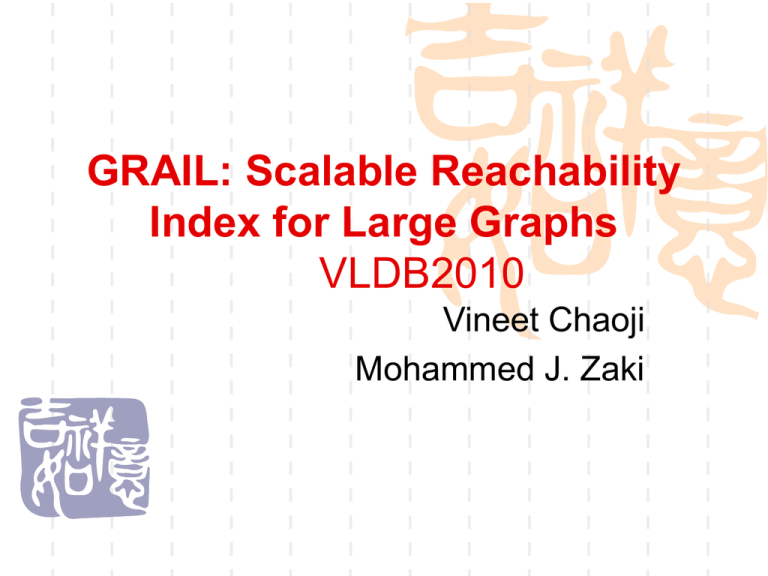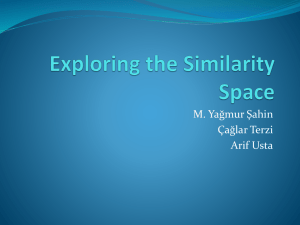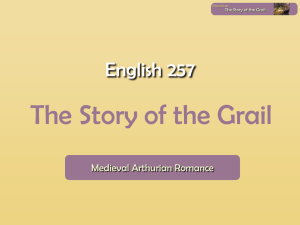GRAIL: Scalable Reachability Index for Large Graphs
advertisement

GRAIL: Scalable Reachability
Index for Large Graphs
VLDB2010
Vineet Chaoji
Mohammed J. Zaki
1. INTRODUCTION
Problem Definition
Given a directed graph G = (V,E) and two nodes u, v
∈ V , a reach ability query asks if there exists a path
from u to v in G. If u can reach v, we denote it as u →
v
Application
Semantic Web is composed of RDF/OWL data and
Reach ability queries to infer the relationships among
the objects.
network biology, reachability querying protein-protein
interaction networks
DAG 1
the problem of reachability on directed
graphs can be reduced to reachability on
directed acyclic graphs (DAGs)
equivalent DAG G′
each node represents a strongly connected
component of original graph, each edge
represents whether one component can
reach another.
DAG 2
answer whether node u can reach v in G
look up their corresponding strongly connected
components, Su and Sv, respectively, which are the
nodes in G′. If Su = Sv, then u and reach v, If Su !=
Sv, then we pose the question whether Su can reach
Sv in G′.
reachability queries on the original graph can be
answered on the DAG, and thus we will discuss
methods for reachability only on DAGs.
Tradeoff between Query Time and
Index Size
Basic Approach: interval
labeling
reachability problem on trees can be solved
effectively by interval labeling ; linear time and
space for constructing the index, and provides
constant time querying.
Definition
each node u with a range Lu = [rx, ru]
ru:denotes the rank of the node u in a post-order
traversal of the tree, ranks begin at 1, and all the
children of a node ordered and fixed for that
traversal(reversed visiting order compared with rx)
rx: DFS from root, number of nodes that
has been popped + 1 currently
Theorm 0
For trees, u → v ⇐⇒ Lv ⊆ Lu.
Proof:
Consider one step reachability,
if u → v in one step, then for rx: u will be visited
before v, so rx(u)<=rx(v); for ru: u will be visited in
DFS before v, so, ru(u) >= ru(v), clearly Lv ⊆ Lu.
If Lv ⊆ Lu, then rx(u)<=rx(v), rx(u)<=rx(v) means u is
visited before v in DFS process, and consider
constraint of tree, so u → v in one step
Now because relationship u → v , Lv ⊆ Lu is
equivalent relationship, and path_num(u,v) is at most
1, so u → v ⇐⇒ Lv ⊆ Lu(1 step) can deduce u → v
⇐⇒ Lv ⊆ Lu(n step)
generalize the interval labeling to a
DAG
ensure that a node is not
visited more than once,
and a node will keep the
post-order rank of its first
visit.
interval containment of
nodes in a DAG is not
exactly equivalent to
reachability.
For example, 5 !→ 4, but
L4 = [1, 5] ⊆ [1, 8] = L5.
3. THE GRAIL APPROACH
The key idea is to do fast elimination for
pairs of query nodes for whom nonreachability can be determined via the
intervals.
employs multiple intervals that are
obtained via random graph traversals.
symbol d denote the number of intervals
to keep per node
THE GRAIL APPROACH
Definition
THEOREM 1
two main issues in GRAIL
i) how to compute the d random interval
labels while indexing
ii) how to deal with exceptions, while
querying
3.1 Index Construction
The best strategy is to cease labeling after
a small number of dimensions (such as 5),
with reduced exceptions, rather than
trying to totally eliminate all exceptions
Traversal Strategies
Randomized: shown in Algorithm 1, with a
random traversal order for each dimension.
Randomized Pairs: first randomize the order of
the roots and children, and fix it. We then
generate pairs of labeling, using left-to-right (LR) and right-to-left (R-L) traversals.
Bottom Up: this strategy we conceptually
“reverse the edges” and process the nodes in
reverse topological order. The bottom-up
traversal can be done at random, or in randompairs.
3.2 Reachability Queries
Exception’s Definition
For example, for the DAG in Figure 2(b),
we can see that E2 = {1, 4}, E4 = {3, 7, 9},
keeping explicit exception lists per node
does not scale to very large graphs.
Default approach in GRAIL is to use a
“smart” DFS, with recursive containment
check based pruning, to answer queries.
Computational Complexity
querying takes O(d) time if Lv !⊆ Lu
exception lists are to be used, and they are
maintained in a hash table, then the check in
Line 3 takes O(1) time; otherwise, if the
exceptions list is kept sorted, then the times is
O(log(|Eu|)).
default option is to perform DFS, but note that it
is possible we may terminate early due to the
containment based pruning. Thus the worst
case complexity is O(n + m) for the DFS
4.1 Datasets
Small-Sparse: These are small, real graphs,
with average degree less than 1.2,
Small-Dense: These are small, dense realworld graphs
Large-Real: To evaluate the scalability of
GRAIL on real datasets, we collected 7 new
datasets which have previously not been been
used by existing methods
Large-Synthetic: To test the scalability with
different density setting, we generated random
DAGs, ranging with 10M and 100M nodes, with
average degrees of 2, 5, and 10.
4.2 Small Real Datasets: Sparse
and Dense
Tables 7, 8, and 9 show the index construction
time, query time, and index size for the small,
sparse, real datasets.
Tables 10, 11, and 12 give the corresponding
values for the small, dense, real datasets.
The last column in Tables 8 and 11 shows the
number of reachable query node-pairs out of
the 100K test queries; the query node-pairs are
sampled randomly from the graphs
4.2 Small Real Datasets: Sparse
and Dense
Conclusion
On the sparse datasets, GRAIL (using d = 2
traversals) has the smallest construction time
In terms of query time, PathTree is the best; it is 3100 times faster than GRAIL
DFS gives reasonable query performance
On the small dense datasets, GRAIL (with d = 2) has
the smallest construction times and index size.
indexing does deliver significant benefits in terms of
query time performance.
4.3 Large Datasets: Real and
Synthetic
Table 13 shows the construction time, query time, and
index size for GRAIL (d = 5) and pure DFS, on the large
real datasets.
We also ran PathTree, on cit-patents and citeseerx is
aborted with a memory limit error (–(m)), whereas for
the other datasets it exceeded the 20M ms time limit (–
(t)).
Table 14 shows the construction time, query time and
index sizes for GRAIL and DFS on the large synthetic
graph
GRAIL is uniformly better than DFS in all cases.
we conclude that GRAIL is the most scalable
reachability index for large graphs, especially with
increasing density
4.4 GRAIL: Sensitivity
Table 15 shows the effect of using
exception lists in GRAIL
Using exceptions does help in some
cases, but increase construction time, and
the large size of exception lists, do not
justify the small gains. exceptions could
not be constructed on the large real
graphs.
Number of Traversals/Intervals (d)
increasing the number of intervals
increases construction time, but yields
decreasing query times.
at some point the overhead of checking a
larger number of intervals negates the
potential reduction in exceptions. (query
time increases from d = 4 to d = 5 for ecoo)
trade-off in query cost v.s. index size
To estimate the number of traversals that
minimize the query time, or that optimize
the index size/query time trade-off is not
straightforward.
However, for any practical benefits it is
imperative to keep the index size smaller
than the graph size. This loose constraint
restricts d to be less than the average
degree.
Effect of Reachability
For all of the experiments above, we issue 100K
random query pairs. However, since the graphs
are very sparse, the vast majority of these pairs
are not reachable
As an alternative, we generated 100K reachable
pairs by simulating a random walk
Tables 16 and 17 show the query time
performance of GRAIL and pure DFS for the
100K random and 100K only positive queries,
on some small and large graphs
Observation
Generally speaking, querying only
reachable pairs takes longer (from 2-30
times) for both GRAIL and DFS. Note also
that GRAIL is 2-4 times faster than DFS
on positive queries, and up to 30 times
faster on the random ones.
Effect of Query Distribution
for query sets with all reachable (positive)
node-pairs, CV (coefficient of variation)
decreases for GRAIL since the likelihood
of pruning and early termination of the
query decreases.
Effect of Density
generating random DAGs with 10 million
nodes, and varying the average density
from 2 to 10, as shown in Figure 5.
both the construction and query time
increase with increasing density.
GRAIL (with d =5) is an order of
magnitude faster than pure DFS in query
time.
Question Remained
The question whether there exists an interval
labeling with d dimensions that has no
exceptions, is likely to be NP-complete.
My Opinion:
Algorithm 1 is based on DFS coding vertex
Each coding instance could be mapped to a DFS tree
of graph G
So, d should as large as Number of trees for G to
guarantee no exceptions
Number of trees for G is exponential for nodes
number in G
That problem is not NPC






